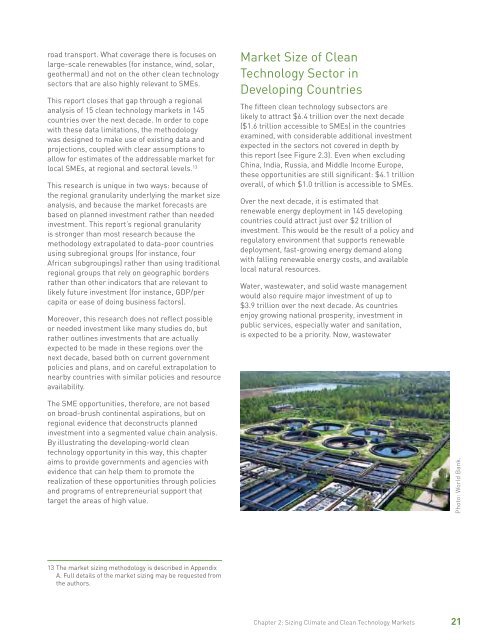Building Competitive Green Industries
green-industries
green-industries
You also want an ePaper? Increase the reach of your titles
YUMPU automatically turns print PDFs into web optimized ePapers that Google loves.
oad transport. What coverage there is focuses onlarge-scale renewables (for instance, wind, solar,geothermal) and not on the other clean technologysectors that are also highly relevant to SMEs.This report closes that gap through a regionalanalysis of 15 clean technology markets in 145countries over the next decade. In order to copewith these data limitations, the methodologywas designed to make use of existing data andprojections, coupled with clear assumptions toallow for estimates of the addressable market forlocal SMEs, at regional and sectoral levels. 13This research is unique in two ways: because ofthe regional granularity underlying the market sizeanalysis, and because the market forecasts arebased on planned investment rather than neededinvestment. This report’s regional granularityis stronger than most research because themethodology extrapolated to data-poor countriesusing subregional groups (for instance, fourAfrican subgroupings) rather than using traditionalregional groups that rely on geographic bordersrather than other indicators that are relevant tolikely future investment (for instance, GDP/percapita or ease of doing business factors).Moreover, this research does not reflect possibleor needed investment like many studies do, butrather outlines investments that are actuallyexpected to be made in these regions over thenext decade, based both on current governmentpolicies and plans, and on careful extrapolation tonearby countries with similar policies and resourceavailability.Market Size of CleanTechnology Sector inDeveloping CountriesThe fifteen clean technology subsectors arelikely to attract $6.4 trillion over the next decade($1.6 trillion accessible to SMEs) in the countriesexamined, with considerable additional investmentexpected in the sectors not covered in depth bythis report (see Figure 2.3). Even when excludingChina, India, Russia, and Middle Income Europe,these opportunities are still significant: $4.1 trillionoverall, of which $1.0 trillion is accessible to SMEs.Over the next decade, it is estimated thatrenewable energy deployment in 145 developingcountries could attract just over $2 trillion ofinvestment. This would be the result of a policy andregulatory environment that supports renewabledeployment, fast-growing energy demand alongwith falling renewable energy costs, and availablelocal natural resources.Water, wastewater, and solid waste managementwould also require major investment of up to$3.9 trillion over the next decade. As countriesenjoy growing national prosperity, investment inpublic services, especially water and sanitation,is expected to be a priority. Now, wastewaterThe SME opportunities, therefore, are not basedon broad-brush continental aspirations, but onregional evidence that deconstructs plannedinvestment into a segmented value chain analysis.By illustrating the developing-world cleantechnology opportunity in this way, this chapteraims to provide governments and agencies withevidence that can help them to promote therealization of these opportunities through policiesand programs of entrepreneurial support thattarget the areas of high value.Photo: World Bank.13 The market sizing methodology is described in AppendixA. Full details of the market sizing may be requested fromthe authors.Chapter 2: Sizing Climate and Clean Technology Markets21


